SDSU vs Oregon State: Ten Things to Watch
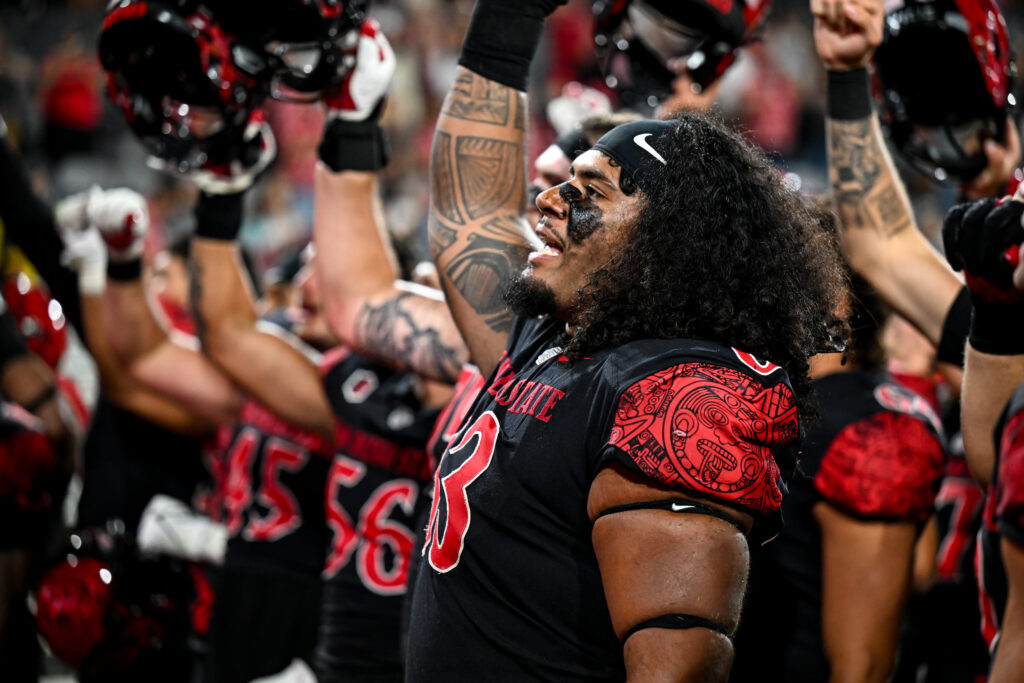
Ross Ulugalu-Maseuli sings the fight song with his teammates after an SDSU victory. (PJ Panebianco/EVT)
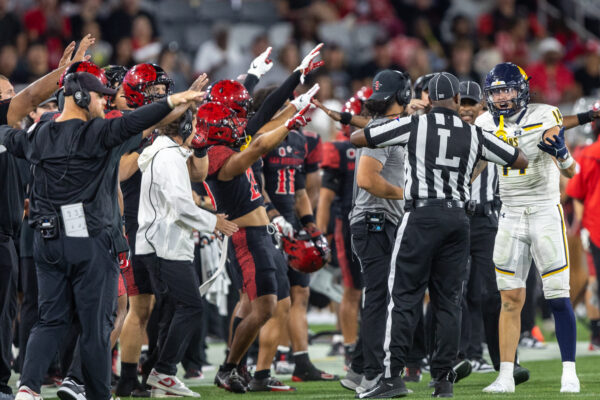
Contrasting styles make for great football games. By that standard, SDSU and Oregon State should be electric.
When the Aztecs hired Lewis and his uptempo attack, it departed from the philosophy that made it the 19th-winningest FBS program in the country over the past decade. After one losing season in 14 years, Athletic Director JD Wicker decided to leave the Brady Hoke/Rocky Long era in the past.
While the merits of that decision will play out over the coming years, Saturday has the feeling of déjà vu.
After seven straight losing seasons, the Beavers, under former head coach Jonathan Smith, turned their fortunes in 2021. Smith led OSU to three consecutive winning campaigns, including ten victories in 2022. In November, Michigan State hired Smith as its head coach. The school promoted defensive coordinator Trent Bray to replace Smith.
That story bears a striking similarity to what took place on The Mesa. In 2009, SDSU hired Hoke. After two seasons, he reversed the decade of futility that preceded him. Buoyed by his success with the Aztecs, another Michigan school hired him away. The university replaced Hoke with defensive coordinator Rocky Long.
At the time of Hoke’s first departure, SDSU’s fan base was willing to accept a run-first, defensive-oriented style as long as it led to winning. OSU was in a similar position after losing in the conference realignment rat race the past two years. Elevating Bray was an obvious decision for the university.
When Hoke retired in November, the SDSU community demanded a change. Enter Lewis. Saturday’s contest pits the Aztecs’ former style with its new one.
Below are ten things to watch as the Aztecs take on the Beavers on Saturday.
10. Lewis’ system against Power Schools at home
When Lewis led Kent State from 2018-2022, the school’s policy was to use the football team’s schedule to make money to fund its athletic departments. Lucrative buy-games were the norm.
Except for the COVID season in 2020, the Golden Flashes competed in four non-conference games each season, three of which were on the road against P5 schools.
The deep-pocketed programs got their money’s worth. In twelve games across four seasons, Lewis’ squads lost by an average score of 41-13. Kent State never played schools from the autonomous conferences at home.
The lopsided outcomes skewed KSU’s stats and made evaluating Lewis’ football philosophy challenging. Few programs in the country signed up to compete against the murderer’s row that the Golden Flashes faced each season. Even SEC schools schedule FCS opponents in the heart of their conference slate.
Oregon State marks the first time Lewis gets to compete against traditional power schools with a home field advantage as a head coach. If the Aztecs win on Saturday, it will be Lewis’ first victory over a team of that caliber.
9. Keeping things on schedule
The contrasting virtues of a ball-control and fast-paced spread offense played out at different times last Saturday. Texas A&M-Commerce started the game by establishing the run. Eighteen of its 29 first-half plays kept the ball on the ground. The strategy allowed a 34-point underdog to take a 6-3 lead into intermission.
In the third quarter, TAMCU moved to more spread concepts. They went from a slight lead in time of possession to a huge deficit. The Lions had the ball for over five fewer minutes than SDSU in the third. Showing the power of Aztec Fast, the Red and Black exploded, turning a three-point deficit into a 17-point advantage one play into the fourth quarter.
Unlike TAMCU, Oregon State will not abandon the power running game. They possessed the ball for 37:29 last Saturday against Idaho State. Twenty-four of OSU’s 29 first downs came on the ground. If the Beavers approximate that number this week, the Snapdragon faithful will leave unhappy.
Expect to see OSU’s dynamic RB duo early and often. If SDSU can force multiple third and longs, it could change the game.
Offensively, the Aztecs also need to stay on schedule. A strength of Lewis’ system is that he can scheme positive plays. That aspect of his offense excels in third and short.
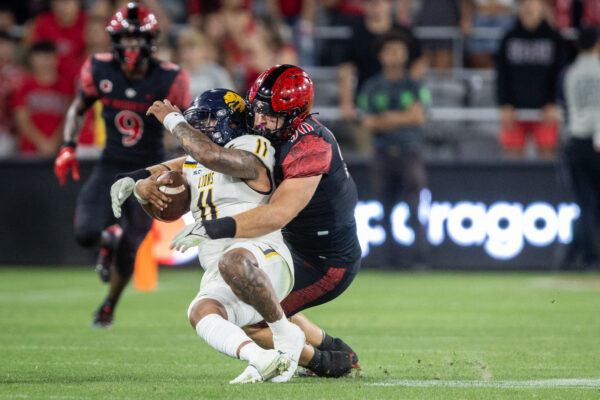
8. Reverting to the 3-4
After an entire offseason of trying to understand the team’s new 4-2-5 defense, SDSU started its opener in a 3-4 to match TAMCU’s personnel. Nose tackles Sam Benjamin and Teivis Tuioti, plus DT Krishna Clay, had their hands on the ground to counter the Lions’ two tight end formations. Defensive coordinator Eric Schmidt flanked the three interior linemen with his stoutest EDGE defenders, Trey White and Brady Nassar. STUD safety Deshawn McCuin began the game on the sideline.
Oregon State utilized 12 personnel frequently to rack up 362 rushing yards. Amazingly, their longest run of the day was just 23 yards. The Beavers typically presented a balanced front with tight ends on both sides of the formation. Will the Aztecs match OSU’s size to be stout up front? What do they sacrifice by playing one fewer defensive back?
How SDSU stacks up on Saturday will also give insight into the running teams they face down the road. Teams like Boise State, Wyoming, and Air Force will also try to win on the ground.
7. Who develops players better?
SDSU and Oregon State have met six times. The first was a 1972, 17-8, victory by the Aztecs. The sixth was last year’s 26-9 OSU win. Due to the shakeups for both schools this offseason, the 1972 game is about as helpful as the 2023 iteration in preparing for Saturday’s contest.
San Diego State LT Christian Jones and OSU LG Joshua Gray are the only starters from last year expected to do the same this week. Nine Beavers made their first college starts against Idaho State, and a dozen athletes started their first games for OSU. SDSU has the fourth fewest returnees (54) in the country.
Despite having a slightly larger roster turnover, the Aztecs have an experience advantage against OSU. The Beavers have a combined 293 career collegiate starts. SDSU has 375. Each squad has one vet with over 40 starts (Gray and Marquez Cooper) and one in the 30s (Kobe Singleton and Nate Bennett).
The Aztecs’ biggest advantage is players with double-digit starts. They have 17 of these athletes. OSU has 10. Nine of SDSU’s most experienced athletes started week one. The Beavers counted on seven of their ten at the beginning of their Idaho State game.
247Sports ranks Oregon State as its 73rd most talented team. SDSU is 76th. EA Sports 2025 has both teams as 79 overall. The talent is equal. How the coaches have developed them will determine the outcome.
Jeff Sobol leads SDSU’s strength and conditioning effort. Mike McDonald heads OSU’s. Saturday’s tussle is as much a competition about their work in the offseason as it is Lewis and Bray matching wits.
6. Winning the numbers game
Limiting SDSU’s big plays is a key for Oregon State on Saturday. Every touchdown drive for the Aztecs against TAMCU had an explosive play over 20 yards. Preventing large gains usually means employing two high safeties to cover long passes and charging the back end to come up quickly against the run.
If OSU employs this set, only six defenders will be in the box to stop the run. Power schools often use this tactic against G5 squads because they believe their superior talent means they can win without an extra defender in the box. Can the Beavers stop Marquez Cooper without committing more people inside?
OSU’s secondary has athletes from each grade, but only SR CB Jaden Robinson has more than ten starts. Redshirt freshman CB Andre Jordan will be making his second career start against the Aztecs. Sophomore NK Noble Thomas Jr, junior FS Jack Kane, and SS Skyler Thomas have six, four, and three starts under their belts. Aztec Fast puts pressure on the back end to recognize and react. Without a lot of experience to draw upon, will assignment errors lead to SDSU points?
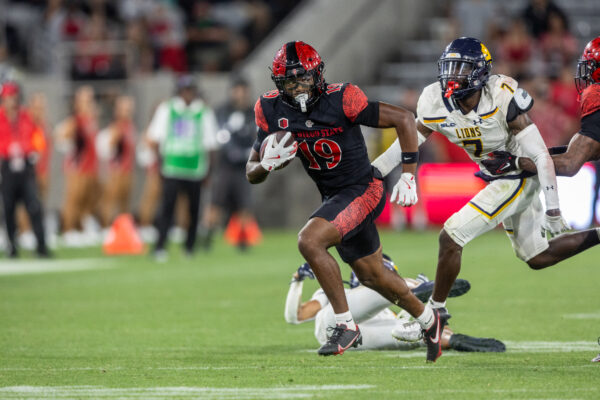
5. Health at Wide Receiver
Mekhi Shaw missed most of the opener with a leg injury. He had one punt return and entered the game as a wide receiver but was limited. His health could make a huge difference in the contest. SDSU was potent at two receiver spots but did not impress at the third. Shaw’s return could change that.
The depth chart lists Shaw as the starter at Wide Receiver (1). Behind him, Jerry McClure and Nate Bennett are listed as backups. McClure starred in scrimmages this fall and raised his profile, but was in street clothes last week. In Shaw and McClure’s absence, Bennett saw a lot of time but did not have a reception. His best opportunity came on a deep ball that he did not make a play on.
Another intriguing possibility is moving Ja’Shaun Poke or Jordan Napier outside to allow them to play together. Their ability to get off the line of scrimmage will dictate if they can be on the field at the same time.
4. Attacking Linebackers
OSU’s three leading tailbacks only lost four combined yards on 51 carries. For SDSU to get the Beavers off schedule, it needs better play from its linebackers on Saturday. Tano Letuli tied for the team lead with seven stops, but none of them amounted to a loss for TAMCU. He did record a 0.5 TFL, but it was a stop at the line of scrimmage.
As a group, Kyle Moretti (3 solo), Brady Anderson (2 solo), Cody Moon (2 assisted), Owen Chambliss (2 assisted), and DJ Herman (1 assisted) added ten more tackles. TAMCU did not challenge SDSU’s linebackers. That is going to change with Oregon State.
Wide receiver Taz Reddicks paced OSU’s skill position players with 50 snaps. WR Trent Walker had 47. Tight ends Bryce Caufield (43) and Jermaine Terry II (42) were next on the list. With 12 personnel likely to be the base offense for much of the day, the defensive line will be double-teamed frequently, and it will be up to the linebackers to fill holes and bring down ball carriers before they can get to the second level.
3. Whose wrinkles work?
Oregon State offensive coordinator Ryan Gunderson said this week that he intended to be more balanced against Idaho State but adjusted his playcalling because the ground game proved potent. Will the Aztecs see a different approach?
Starting QB Gevani McCoy’s 55-yard touchdown pass was a thing of beauty. He threw open his receiver in double coverage. He is an experienced signal caller who will have a bigger role against the Aztecs. Without much tape to base their coverage against McCoy, SDSU could be at a disadvantage.
SDSU hardly used motion on offense, and its tempo rarely approached breakneck speed. Its formation choices were straightforward. Is Lewis’ offense vanilla in this regard because it allows his team to play quicker, or did he not want to show OSU how the Aztecs prefer to line up?
Defensively, SDSU varied its fronts a lot. Countering that offensively can be challenging. With so many new faces, OSU will not be adept at competing against everything the Aztecs can throw at them. A lack of continuity will also impact the Aztecs. There will likely be a larger gap between personnel groups than later in the year.
In close contests, trick plays can also dictate momentum. Does either side have something creative to create a big opportunity?
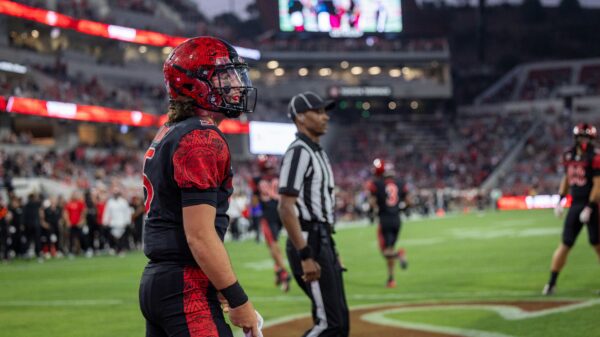
2. Danny O’Neil’s second start
One of only two true freshman starting QBs in the country, every week will offer a new opportunity for Danny O’Neil. Last Saturday, he proved he could lead a DI team to a victory. The game turned when his play elevated.
O’Neil has yet to start a game well. Without extensive opportunities to prove otherwise, O’Neil has come out at the beginning of his three public appearances not playing his best football. The difference between last Saturday and the scrimmages in the offseason was he had time to get his feet under him. It took most of the first half against TAMCU before he hit his stride.
SDSU’s starting QB was not the only player who needed to warm up. WR Louis Brown IV, for example, had a great game. Early in the contest, he took an incorrect release on one play and dropped a ball on another. The penalties that plagued the offensive line subsided in the second half.
Once O’Neil got going, he played at an elite level, finishing the game completing 11 of his final 12 attempts. The Aztecs won’t need that level of accuracy from their starting signal caller, but they need him to play well at the beginning of the game.
There is not enough tape on O’Neil to game plan for him yet. He won’t have to make adjustments against Oregon State. The Beavers will take an educated guess on how to slow him down. If they are right, the rest of SDSU’s schedule will copy it until O’Neil adjusts.
One possible approach they might employ is to take away O’Neil’s first read. Many of his best plays were designed by Lewis with one place to throw the football.
The Beavers like to play zone. Sitting on bubble screens with corners in the flats or taking away quick slants with linebackers could force O’Neil to move off his intended target. What happens next will be the first time anyone has seen the freshman react to that situation.
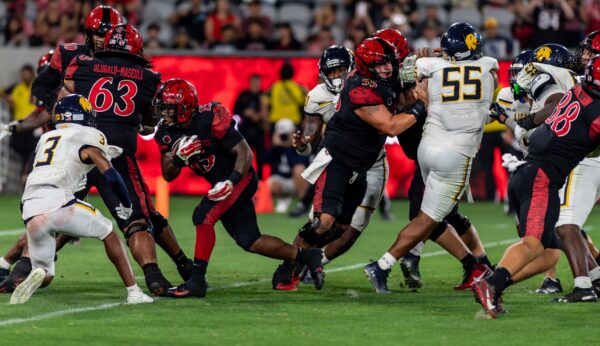
1. The best back in the country
At the postgame press conference last weekend, Marquez Cooper confidently declared that he is the best running back in the country. Cooper is a terrific blend of confidence and humility. His words expressed conviction, not conceit. He was more articulate in praising his offensive line than himself.
Cooper currently has the 123rd most DI career rushing yards all-time. With 135 yards on Saturday, he will pass former Baylor great Shock Linwood for a spot in the Top 100. The star running back would already have been there if not for subpar outings against Power 5 schools.
Lewis had Cooper as his tailback for half of the games described at the beginning of this article. Including a pair last year at Ball State, Cooper has had eight opportunities against the most-resourced schools but has only produced one terrific game.
In 2022, he had 21 carries for 90 yards and a touchdown on the road against No. 1 Georgia. In the other seven contests, he averaged 2.9 yards per attempt on 91 carries for 260 yards.
Without their best player dominating the action, Cooper’s teams lost. The closest a squad that he led came to pulling off an upset was that Georgia game. The Bulldogs won 39-22.
Cooper’s claim as the country’s top back cannot hold merit until he has great games against top competition. The playing field has been skewed against Cooper and every team he has played on over his career.
Oregon State joined the Pac-12 in 1964. They have had a 60-year advantage over SDSU. They will arrive at Snapdragon Stadium on Saturday on near equal footing with the Aztecs in college football’s pecking order.
If Cooper can be the best player on the field, he can put the Beavers in their proper place and prove to the nation that his words were more than bravado.
My earliest sport’s memory involve tailgating at the Murph, running down the circular exit ramps, and seeing the Padres, Chargers and Aztecs play. As a second generation Aztec, I am passionate about all things SDSU. Other interests include raising my four children, being a great husband and teaching high school.